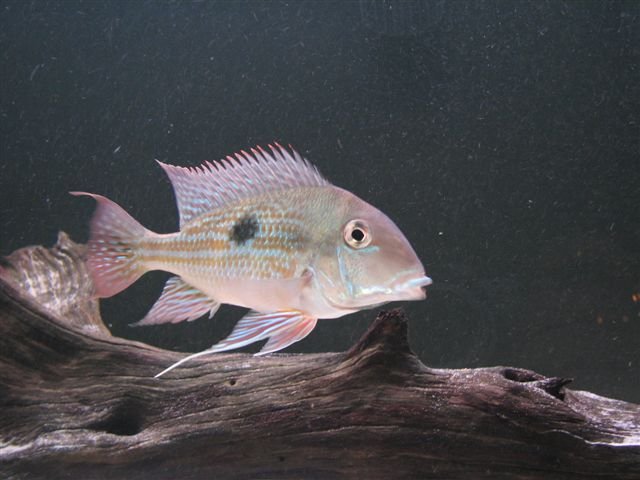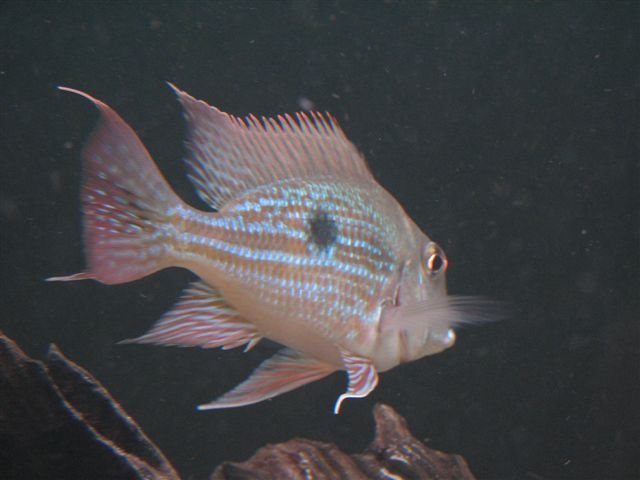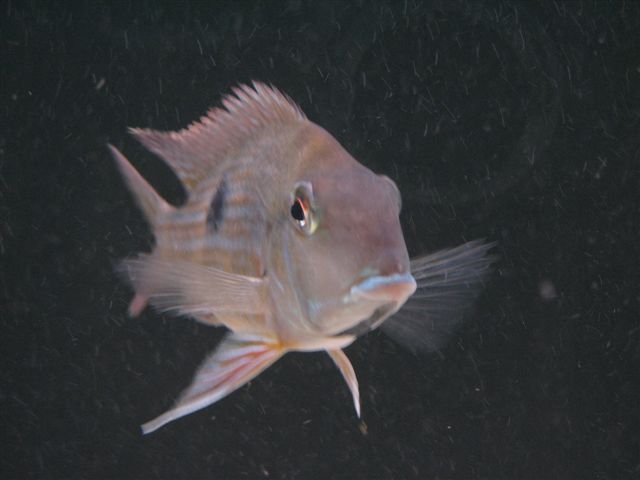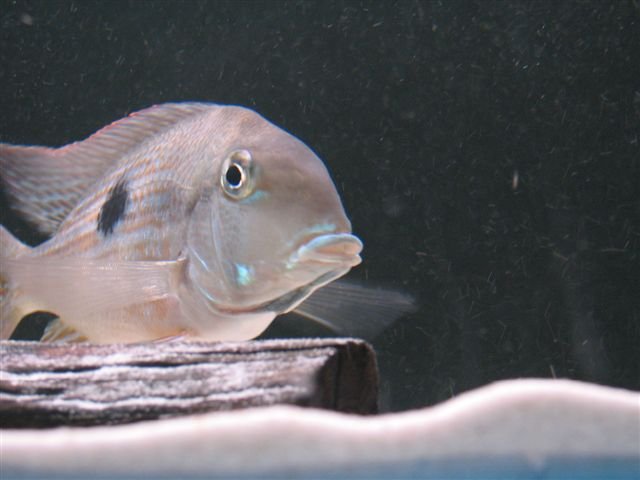many taxonomists have reported statistically significant differences between geographic "races" of G. surinamensis (e.g., Guyanan versus Amazonian, etc.), but many others, considered "lumpers," refused to split these into distinct species — preferring, to consider all of them as simply variants of Geophagus surinamensis.
Like science, like hobby. Most cichlid hobbyists can recognize Geophagus surinamensis in the same way that they can easily identify Satanoperca "jurupari." The surinamensoids are typically elongate, generic eartheaters in shape. However, the mouth is not quite as underslung as in the juruparoids.
Their distinctive coloration includes a dark mid-lateral blotch and characteristic alternating blue/green and red iridescent longitudinal stripes. The dorsal, anal, caudal and even the ventral fins are often spotted or streaked in red, white and blue. If you've ever kept them or really looked at various shipments at your dealer, you will have noted subtle variations on the colorational theme of "surinamensis." Some have striped tails, others are spotted, some have additional black spots on their gill plates, some have black throats, the size of the mid-lateral blotch varies, the height and length of the body is variable, etc.
If you believe Gosse (and others before him), who classified Geophagus surinamensis as a single, widely distributed species found throughout South America, then you will have no trouble integrating these observations under the simple explanation of "geographic variation." However, this has proven to be the wrong interpretation.
But what names to put to them? The Germans applied the noncommittal names "ovophilic" and "larvaphilic" to distinguish between those that picked up the eggs immediately (advanced mouthbrooders) and those that guarded the eggs and chewed the fry out of their shells (delayed mouthbrooders).
I believe that some of the earlier names (e.g., megasema, altifrons, proximus, etc.) could be assigned on the basis of coloration and geographic origin, so I suggest that the Guyanan black-throat form was G. surinamensis, and that the "spot-tail" and "flag-tail" forms were respectively G. altifrons and G. megasema. These designations have been subsequently followed in the literature (Stawikowski and Werner 1988).
Kullander (1986) decided that the surinamensoid from Peru was Geophagus proximus, and, more recently, Kullander and Nijssen (1989) suggested that the aquarium surinamensoid from Guyana (black-throat) is not G. surinamensis but rather the newly described G. brachybranchus. Apparently the real G. surinamensis is restricted in its distribution to Surinam itself, an area that is not a focus for commercial collecting. Geophagus brachybranchus joins G. harreri Gosse (1976) and G. camopiensis Pellegrin (1903), two previously described surinamensoid-like eartheaters from the Guyanas, along with G. brokopondo, yet another new species from a very limited area described by Kullander and Nijssen (1989).
In terms of the hobby, G. brachybranchus (black-throat Guyanan), G. megasema (flag-tail Amazonian), and G. proximus (huge-spot Peruvian) are the usual forms available, all sold under the name Geophagus surinamensis (and sometimes the older, invalid name "G. thayeri"). Both G. harreri and G. camopiensis are in Europe, returned there by enthusiasts who collected them from Surinam and French Guiana, but don't look for them in the American hobby anytime soon (pictures in Stawikowski and Werner 1988).
There are several undescribed species that appear infrequently. There is a very elongate (and very belligerent) undescribed form from Venezuela dubbed "Wangenstrich Erdfresser" (cheek-striped eartheater) for the vertical "bandit" stripe extending from the eye down the gill covers. There are also several surinamensoids being exported from the Rio Tocantins/Rio Xingu area, now that this area has been opened primarily for the fantastic loricariid (suckermouth) catfish it has provided. One of these, an otherwise drab fish notable for a mid-lateral splotch ringed by iridescent scales (unique among surinamensoids) has recently been named G. argyrostictus by Kullander (1991). References
Axelrod, H. 1978. The eartheaters, Geophagus jurupari and Geophagus surinamensis. In: Breeding Aquarium Fishes, Vol. 5, Pp. 102-126. TFH Pub., Neptune, New Jersey.
Axelrod, H. 1980. Exotic Tropical Fishes. TFH Pub., Neptune, New Jersey.
Brind, W. 1943. A new species of Geophagus, Geophagus magdalena. Brind, "The Magdalena Mouthbrooder." All Pets Mag. 14(9).
Gosse, J.-P. 1975. Revision du genre Geophagus (Pisces: Cichlidae). Monograph. Mem. Acad. Roy. Sci. Outre mer (Bruxelles) 19(3):1-172.
Gosse, J.-P. and S. O. Kullander. 1981. The zoological name of the red-hump Geophagus. Buntbarsche Bulletin 83:12-17.
Kiefel, V. H. 1992. Der "Tr„nenstrich Erdfresser" aus dem Rio Xingu: Geophagus argyrostictus. DATZ 45:152-154.
Kullander, S. O. 1986. Cichlid fishes of the Amazon river drainage of Peru. Monograph. Swed. Mus. Nat. Hist., Stockholm, Sweden.
Kullander, S. O. 1991. Geophagus argyrostictus, a new species of cichlid fish from the Rio Xingu, Brazil. Cybium 15(2):129-138.
Kullander, S. O. and H. Nijssen. 1989. The Cichlids of Surinam, Teleostei: Labroidei. Monograph. E.J. Brill, Leiden, Holland.
Leibel, W. S. 1985. Behavioral evidence for the polytypic nature of Geophagus surinamensis (Bloch 1791). Buntbarsche Bulletin 106:15-23.
Leibel, W. S. 1986. Pellegrin's humped eartheater: introducing the true Geophagus pellegrini. Buntbarsche Bulletin 113:2-15.
Leibel, W. S. 1989. Geophagus pellegrini Regan 1912. ACA Cichlid Index 9(9):1-2.
Loiselle, P. V. 1974. The identity of the Redhump Geophagus. Buntbarsche Bulletin 40:9-22.
Palicka, J. 1992. The care of Geophagus surinamensis. Tropical Fish Hobbyist 40(9):8-12.
Richter, H. J. 1979. The red hump Geophagus. Tropical Fish Hobbyist 25(3):4-14.
Sprenger, K. 1971. The red-humped Geophagus. Buntbarsche Bulletin 26:24-25.
Stawikowski, R. 1990. Oft-brotende Geophagus! DATZ 43(9):519-520.
Stawikowski, R. and U. Werner. 1988. Die Buntbarsche der Neuen Welt: Sudamerika. Reimar Hobbing Verlag, West Germany.
Werner, U. 1984. DCG-Informationen 15(2).
Werner, U. 1992. Der "gelbe Wangenstrich Erdfresser" ist kein Maulbroter! DATZ 45(1):7-8.













